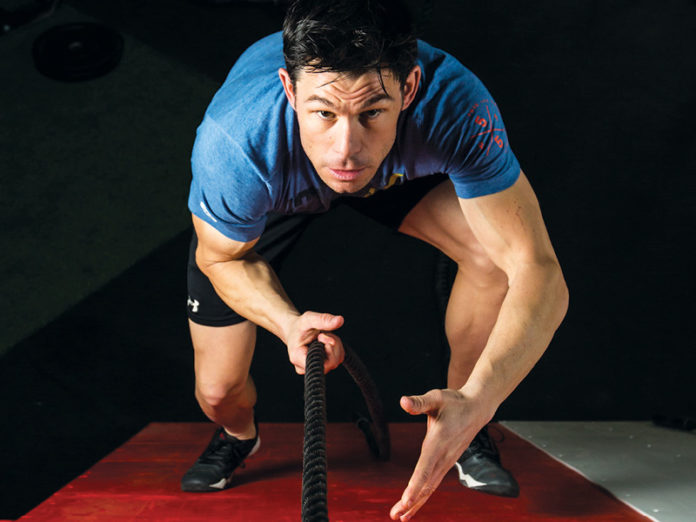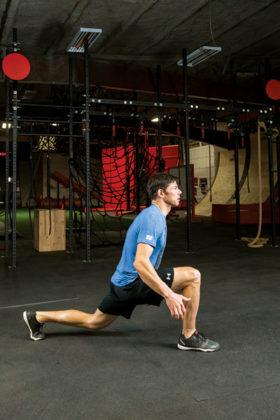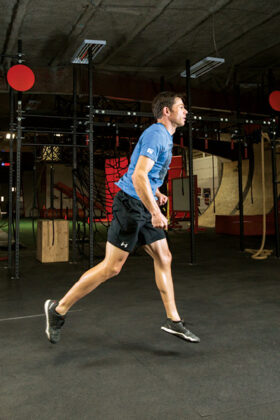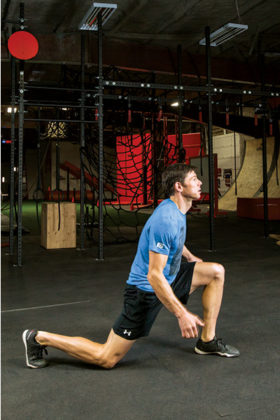
Thousands of people spend weekends getting sweaty, muddy, confused and, let’s face it, bloody, all in the name of fun and fitness in obstacle course racing.
Whether you are a beginner or seasoned off-road athlete, here are some training tips to get you fit for an OCR event or to tackle anything Mother Nature throws at you. While training on the obstacles themselves is ideal, an athlete can easily adapt these tips and workout to a home routine. Let’s get started!
Warm-Up
Begin with an easy 5-8 minute run that changes direction (sideways, backwards and laterally). Add 10 full-extension lunges, 10 burpees and 40 jumping jacks.
Workout
1. Get a leg up
Training legs builds the strength and explosiveness needed to overcome many obstacles. Most people tend to rely on upper body strength in OCR, however muscling through an obstacle with your arms and shoulders may not be the best option, especially on longer races. Your upper body will fatigue much faster than your legs.
Scissor Lunges (Tabata style)
- Begin with left foot forward, bent 90 degrees at the knee.
- Lower knee of trailing leg almost to the ground.
- Bring hands to chest and explode to a full extension jump so feet switch positions.
Squat Jumps
- With toes pointed out and feet shoulder width, squat as low as possible.
- Bring hands in front of your chest and explode out of the squat into a high jump.
- Land softly with bent knees.
Go hard for 20 seconds and rest 10 seconds, first with squat jumps, then scissor lunges and repeat 8 times.

2. Get a grip
Training grip strength will be key to any hang or hold obstacle. Hanging not only becomes a life-skill, but will save you from doing penalty burpees.
Grip Strength
Train grip strength by increasing the duration of a hang from anything (monkey bar, door jamb, rope, etc.).
- Start with 10 second hang and build up in 10-second increments until failure.
- You can train the same muscles by holding weighted objects vertically with just your finger tips.
- Hold a 2-pound object until a 1-minute hold is routine. Gradually increase the weight and time of the holds so you are constantly building strength.

3. Get animal
Become aware of functional, but unconventional movements such as bear crawl and crab walk. These will target your core and leave you stronger mentally and physically, training your body for obstacles such as the barbed wire fence, slanted wall and cargo net.
Bear Crawl
- Begin on all-fours with hands beneath shoulders and the knees below the hips.
- Lift knees off the ground slightly, activating core and shoulders and begin to crawl.
- Reach an arm and the opposite leg forward six to 10 inches with each stride, staying relatively flat.
- Aim for 30 seconds, repeat 8 times.

Crab Walk
- Begin seated on the floor with hands behind you and knees slightly bent.
- Driving through your heels, lift hips off the floor and crawl backwards.
- Aim for 30 seconds, repeat 8 times.
4. Get Running
Running is fundamental in obstacle racing and so many other outdoor activities, so get out and run whenever you can, but make this exercise overload training like in a burden run.
Burden Run:
- Carry an unconventional weight you can sustain for a 3-minute run.
- Increase by 1 minute as you build stamina.
- In the gym we use sandbags, pancakes and cylinders. At home, you can be creative, filling a backpack with weights and carrying it on your shoulders, above your head, with a bear hug, dragging it, or a combination of these adaptations.
- The more unstable the weight sits, the more you will have to engage your core to stabilize the weight.

Learning the Ropes
Using the “J Hook” technique allows you to harness the strength of your legs to power through a rope climb. First, hold yourself up on the rope with your hands. Using your feet, weave the rope from the outside of your body underneath your dominant foot then over your weaker foot, pinching it. Use this foothold as a step to move up the rope. Reposition your hands first, then your feet as you move upwards.




















